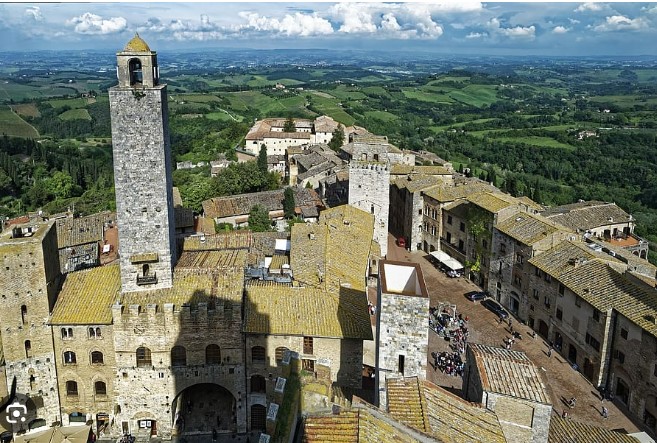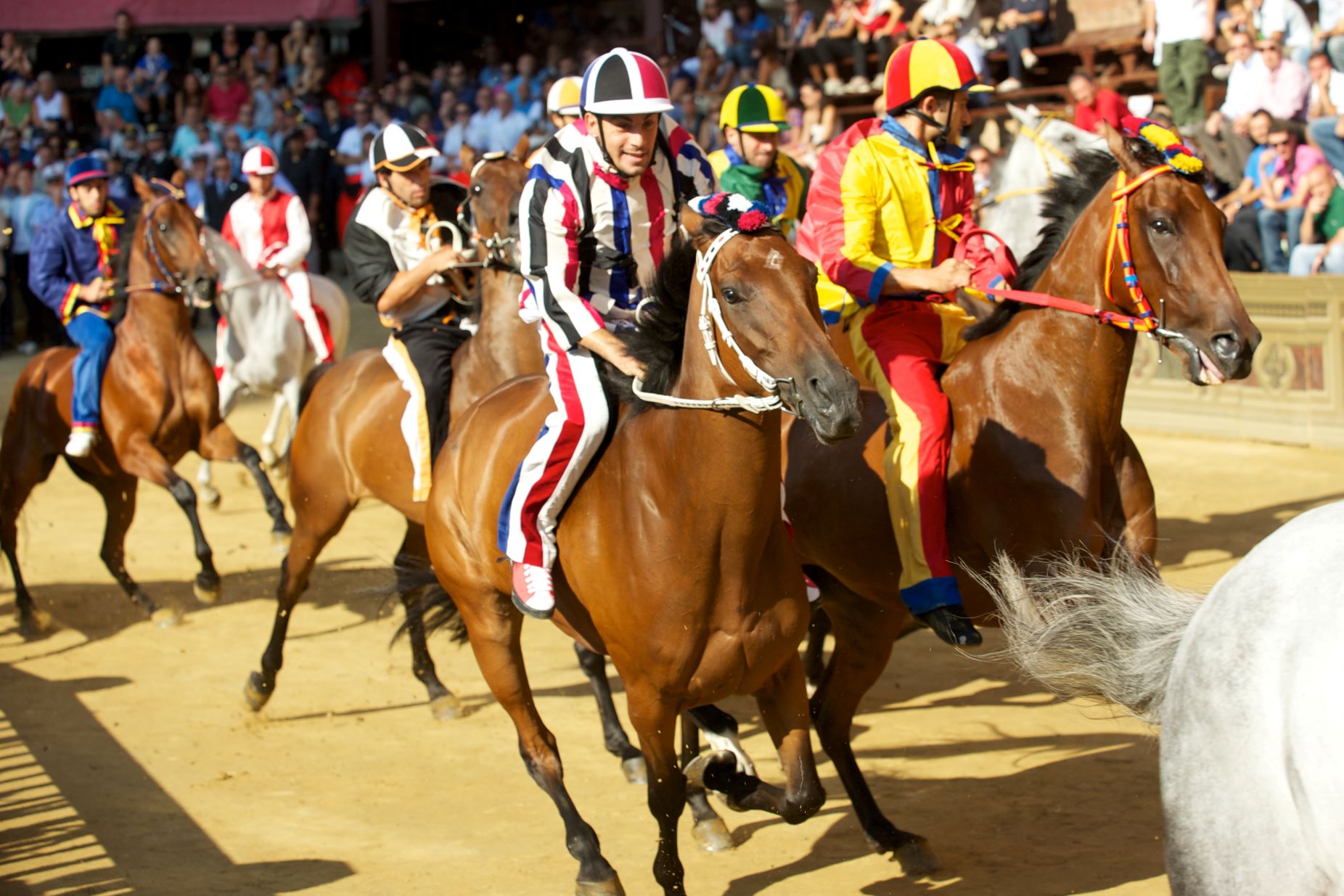If you’re visiting Tuscany you certainly won’t want to miss the important cities that are rich in history, where it seems that little has changed in the last 500 years and the Renaissance seems as alive today as it was then.
Indeed, if you’re in Florence on June 24, you may feel like a time traveler as the city honors San Giovanni, the patron saint. The day is celebrated with a Renaissance fair commemorating the city’s history. The costumes are glorious and the experience totally immersive. It takes place in Piazza Santa Croce, where stalls of crafts, food, music and performances are set up.
Highlights include the historical costume procession that starts in Piazza della Signoria and finishes at the basilica of St. John the Baptist, and the Florentine Historical Football Tournament, a violent and spectacular sport that dates back to the 16th century. The fair concludes with the traditional fireworks on the Arno Riverfront, which light up the sky and the Arno River with the colors of the city.

But Tuscany is so much more than Florence and its other its historic cities. A wonderful itinerary that takes in the history, the spectacular countryside and the wine country can start either in Florence or in Siena. In between you’ll be in Chianti country.
Although Monteriggioni is slightly closer, a good place to make your first stop if you’re starting from Siena, is San Gimignano which is more prominent. This is a small hill town, known as the Manhattan of the Renaissance because of its distinctive skyline of medieval towers. At its peak, the town had 72 tower-houses built by wealthy families as symbols of their power and prestige. Today, only 14 of these towers remain, but they still give the town a unique and impressive appearance.
 The towers reached high into the sky, some unbelievably slim for their height, and it was testimony to the ability of the original architects that so many were still standing. Among the most notable: Torre Rognosa, the oldest; Torre del Podestà, the highest; and Torre Grossa, which is open to the public and offers panoramic views of the surrounding countryside.
The towers reached high into the sky, some unbelievably slim for their height, and it was testimony to the ability of the original architects that so many were still standing. Among the most notable: Torre Rognosa, the oldest; Torre del Podestà, the highest; and Torre Grossa, which is open to the public and offers panoramic views of the surrounding countryside.
San Gimignano also boasts other artistic and historical attractions, such as the Duomo, which contains a magnificent fresco cycle by 14th-century painters; the Chapel of Santa Fina, a masterpiece of Renaissance art by Ghirlandaio and others; and the Palazzo Comunale, which houses a museum and a gallery of paintings by famous artists such as Lippi and Gozzoli.
San Gimignano has been a UNESCO World Heritage Site since 1990, and it draws many visitors. If you climb the Rocca di Montestaffoli, you’ll enjoy a panoramic view of the surrounding countryside.

From San Gimignano, you can easily reach another medieval jewel by bus, car or bike: Monteriggioni, only 10 miles away. Or if you prefer, book a tour of both locations. This town is famous for the wall that completely encircles it, as well as its fourteen watchtowers that earned it a mention in Dante’s Divine Comedy. The town was built in the 13th century as a fortress to defend Siena from Florence—the perennial rivals–and it still preserves its original appearance.
Monteriggioni offers a glimpse into the past, with its narrow streets, stone houses and ancient churches. In the Museum of Medieval Armors and Weapons you can try on replicas of historical costumes and weapons. Great fun!

Both towns are privileged to be situated squarely in the Chianti wine region, which is known for its reds made from Sangiovese grapes. Chianti wines have aromas of red fruits, sour cherries, smoke, herbs, and spices. Some of the best wineries to visit in Chianti are:
Marchesi Antinori: a historic wine producer with a futuristic estate that houses an art collection and a restaurant.
Castello di Brolio: the birthplace of Chianti Classico, where you can visit the castle, garden, and art collection, and taste the wines of the Ricasoli family.

Castello di Verrazzano, crowning a hill about 2 miles north of Greve, the 1000-year-old castle with a rich history and tradition, offers wine tastings and gastronomic experiences. Even more interesting, this is the birthplace of Giovanni da Verrazzano (1485-1528) who discovered the Bay of New York. His feat is commemorated in the Verrazano Narrows Bridge in New York, between Brooklyn and Staten Island. Verrazzano’s logbooksalso recorded the first-known descriptions of the Hudson River and a large part of the Eastern coast of the US. This great Tuscan seafaring family included mapmakers and admirals among its number before dying out in 1819.

Whether you start from one end or the other, you will certainly want to visit both Florence and Siena, two of the most culturally rich and historically significant cities in Italy. Despite obvious similarities, they are quite distinct and reflect their different origins and influences. Siena is a medieval city founded by the Etruscans, that rose to prominence as a banking and trading center in the 13th and 14th centuries. Florence is a Renaissance city that was founded by the Romans and became the cradle of art, literature, and science in the 15th and 16th centuries.
Siena’s architecture is characterized by its Gothic style, with narrow streets, red-brick buildings, and pointed arches. The city’s main attractions include the Piazza del Campo, one of the most beautiful squares in Europe, where the famous Palio horse race takes place twice a year; the Duomo, a stunning cathedral with a striped facade and a mosaic floor; and the Palazzo Pubblico, the seat of the city’s government, which houses frescoes by Simone Martini and Ambrogio Lorenzetti. Siena is also surrounded by countryside and vineyards, offering easy access to some of Tuscany’s most scenic landscapes and wines.

Florence’s architecture, on the other hand, is characterized by its Renaissance style, with wide avenues, elegant palaces, and domed churches. The city’s main attractions include the Duomo, a monumental cathedral with a terracotta dome designed by Brunelleschi; the Uffizi Gallery, one of the world’s finest art museums, which displays works by Botticelli, Leonardo da Vinci, Michelangelo, and Raphael; and the iconic Ponte Vecchio, lined with jewelry shops and art galleries.
Siena and Florence are both worth visiting for their unique cultural heritage and artistic legacy, but they offer different experiences and atmospheres to travelers. Siena is more intimate and traditional, while Florence is more cosmopolitan and dynamic.
But what they share is their proximity to the Chianti wine area with its multitude of wineries that provide you with an opportunity to savor the wines and foods for which Tuscany is renowned.












